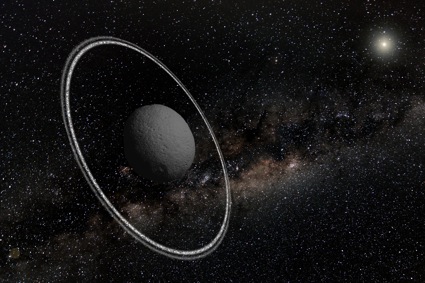
This discovery is the fruit of work carried out by members of a scientific team, which had already discovererd in 1984 rings around Neptune ; team members include Bruno Sicardy, professor at the Pierre and Marie Curie University and associate member of the Paris Observatory ; and Françoise Roques, astronomer at the Paris Observatory. Thirty years later these scientists are once again “guilty” of discovering a miniature ring system around Chariklo. This is a landmark discovery : henceforth, rings are no longer the monopoly of giant planets, and not even of planets.
Situated between Saturn and Uranus in the outer regions of the solar system, 2 billion km from the Earth, 10199 Chariklo is an asteroid belonging to the Centaur group. With a radius of 124 km, it is the largest known of the group. This very dark object was probably ejected less than ten million years ago, from the Kuiper belt as a consequence of gravitational perturbations induced by Uranus.
The discovery of the rings was made on June 3rd 2013 thanks to a stellar occultation. This occultation was observed from about fifteen sites in Brazil, Argentina, Uruguay and Chile, involving both professional astronomers (a total of) and amateurs. The detection of two short extinctions of the star, which occurred symmetrically both before and after its disappearance behind Chariklo, observed from many sites and were disposed along an ellipse, left no doubt that there are two rings : no other explanation, such as cometary jets, is possible.
The structure that emerges is that of two thin, circular and partially transparent rings, with a separation of 8 km. The width of the inner ring, 2013C1R, is 6 to 7 km. The external ring, 2013C2R, is narrower and more diffuse and has a width of 3 à 4 km. « Chariklo’s rings are similar to the narrowest of the rings of Uranus, from the point of view of their width and optical depth. However, they are much smaller from the point of view of their radius : about 400 km instead of 50 000 km. They are "pocket rings" », states Bruno Sicardy.
Scientists did not expect to find rings around Chariklo. To explain their origin, they have proposed several hypotheses, and in particular that of a collision. The latter would have ejected material from the central body, and this material would have reach a stable orbit via an as yet unknown mechanism. The scientists think that this material could, in the future, re-accrete to make up a satellite. But is such a system stable ? What is its lifetime ? Howe many of them are there in the Solar System ? Fascinating questions which challenge theorists and open new research directions.
Reference
This research was published on-line in the 26th of March 2014 issue of Nature, with the title « A ring system detected around the Centaur (10199) Chariklo ».
doi : 10.1038/nature13155
Collaboration
This result is the fruit of an international collaboration, involving eleven French scientists from the Paris Observatory : Bruno Sicardy, Françoise Roques, Emmanuel Lellouch, Nicolas Ligier, Lucie Maquet, Pierre Kervella, Maryame El Moutamid, Jean Lecacheux, François Colas, Frédéric Vachier, Thomas Widemann.

![<multi>[fr]pdf[en]pdf</multi>](IMG/gif/pdf.gif)